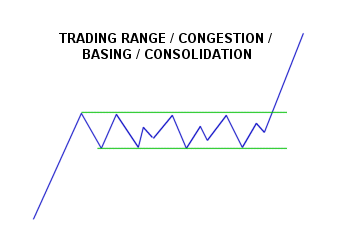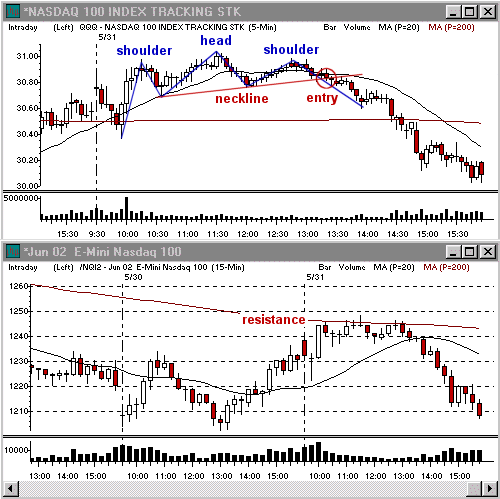Technical Analysis Course – Chart Pattern Course
On this page you’ll find a short introduction to some of the most important chart patterns every trader needs to know.
Technical analysis is the study of market action primarily through the use of charts, for the purpose of forecasting future price trends. It assumes three things: Market action discounts everything.
Price moves in trends.
History repeats itself.
The following patterns are the most recognized and followed. We actively follow and call them all in our Live Trading Room.
Chart Patterns: Select a Pattern
| 1-2-3 Continuation Pattern 2B Setup Ascending Triangle Avalanche Basing Bear Flag Breakout Bull Flag Pattern Bull Trap Congestion Consolidation Core Buy | Core Short Cup-With-Handle Head and Shoulders Oops Daily Buy Pennant Phoenix Reverse Head and Shoulders Symmetrical Triangle Trading Range Wedge (See Pennant) |
1-2-3 CONTINUATION PATTERN:
Criteria:
1. Wide range bar breaking out of support.
2. Narrow range bar near/at the highs of the previous wide range bar. Often this narrow range bar is also an inside range bar.
Entry:�Switch to a smaller time frame and take a breakout from the base or use above the highs of the narrow range bar of bar 2.
Stop:�Under the lows of the base or last major pivot low on the smaller time frame, under the lows of the narrow range bar, or under the lows of the third bar at the time of the setup.
Target:�Bar 1 = Bar 3
THE 2B SETUP:
Criteria: A high followed by a slightly higher high.
Entry:�As the high of the first high breaks on a pullback from the second high. Alternate entry (used by Toni): Under the prior bar’s lows after the second high is made. For instance if the lows of the bar making the second high is $50, entry is under $50. The only time it is not under the bar that made the second high is if that high is followed by an inside range bar, so you would use a break in the lows of the inside range bar.
Stop:�Over the second high.
Target: Price or moving average support.
ASCENDING TRIANGLE:
Criteria: Equal/Nearly equal highs and higher lows on decreasing volume.
Entry:�Breakout from the trend lines on higher then average volume as the trend lines converge.
Stop:�Under the lows of the base or last major pivot low on the smaller time frame or under the lows of the setup bar.
Target:�Equal distance on a breakout comparable to the distance between the first high and first low in the triangle. Ascending triangles tend to breakout higher..
AVALANCHE:
Criteria:
1. Uptrend
2. Stronger than average rally.
3. Pullback of 3-5 bars comparable to or stronger than previous rally, usually on increasing volume, to moving average support (typically the 10, 20 or 30 sma.)
4. Hugs the moving average support on decreasing volume. 4-5 bars average.
5. Moving averages start to converge (10 and 20 sma if it’s setting up on the 20 sma.)
Entry: Switch to smaller time frame and enter on a breakdown in support or going into resistance.
Stop: Over previous or current day’s highs. Usually you will use current day’s highs or intraday resistance.
Target:�Next major simple moving average.
Example:

BASING / TRADING RANGE / CONGESTION / CONSOLIDATION
Example:

BEAR FLAG:
Criteria:
1. Downtrend.
2. Gentle pullback to resistance, such as the 20 sma, on decreasing volume.
Entry: Below the previous bar’s lows or using an intraday breakdown such as a break in the uptrend line of the flag. Volume should start to pick up at this time to confirm the setup.
Stop: Above the previous bar’s highs or above intraday resistance.
Target: New lows, usually on high volume.
BREAKOUT:
Criteria: A base/trading range at highs or lows.
Entry: A breakout in the most recent section of the trading range or trend line in the direction of the trend prior to the trading range. Can also take an entry into moving average support in the case of a long and sma resistance in the case of a short.
Stop: Under simple moving average support such as the 15 minute 20 sma in the case of a setup on the 15 minute chart or under the last pivot low within the trading range.
Target: Moving average resistance (like the 15 minute 200 sma), price resistance (such as a previous pivot), or an equal move to that before the trading range on the move out of the trading range.
Example:
IBC was mentioned in the Live Trading Room on 7/16/2002 to watch on 7/17/2002 and again in the morning on 7/17 as a breakout daytrade.

BULL FLAG PATTERN:
Criteria:
1. Uptrend.
2. Gentle pullback to support, such as the 10 or 20 sma, on decreasing volume.
Entry: Above the previous bar’s highs or using an intraday breakout such as a break in the downtrend line of the flag. Volume should start to pick up at this time to confirm the setup.
Stop: Below the previous bar’s highs or below intraday resistance.
Target: New highs
Example:

BULL TRAP – A gap setup:
Criteria:
1. A bullish daily pattern. Preferably where the market opens at lows and closes at highs.
2. A gap down in the morning, generally on news, whereby the stock opens at or under the previous day’s lows.
Entry: Break in 5 minute lows (A) or an intraday setups such as a breakdown out of a base at lows (B) or a bear flag.
Stop: Depending on the objective and entry. On a break in 5 minute lows for a day or swing trade you can use above the 5 minute highs. For intraday breakdown setups use a stop over the last 5-7 bars or over significant intraday moving average resistance. The same goes for intraday bear flags. For position trades use over the high of the previous day or over the current day’s highs.
Target: Equal distance on a breakout comparable to the distance between the first high and first low in the triangle.
CORE BUY SETUP:
Criteria:
1. Uptrend.
2. Gentle pullback of 3-5 bars average to the 10-20 simple moving average zone on decreasing volume.
Entry: Above the previous bar’s highs or using an intraday breakout. Volume should pick up at this time to confirm the setup.
Stop: Under the previous bar’s lows or under intraday support.
Target: New highs.
Example:
CBH was given in the Live Trading Room on 4/24 as a Core Buy swingtrade.
Example:

CORE SHORT SETUP:
Criteria:
1. Downtrend.
2. Gentle pullback of 3-5 bars average to the 10-20 simple moving average resistance zone on decreasing volume.
Entry: Below the previous bar’s lows or using an intraday breakdown. Volume should start to pick up at this time to confirm the setup.
Stop: Above the previous bar’s highs or above intraday resistance.
Target: New lows, usually on high volume.
CUP WITH HANDLE:
A type of Phoenix.
Criteria: A stock coming out of a downtrend with rounded lows that puts in a slightly lower high and then pulls back gradually to put in a higher low.
Entry: On a breakout higher out of the pullback. There will often be a moving average crossover (such as a cross in the 10 and 20 sma)
Stop: Under lows of the pullback.
Target: Highs of the beginning of the cup or an equal move out of pullback as compared to move off lows.
HEAD & SHOULDERS:
Criteria: High (left shoulder) followed by a higher high (head) and then a lower high (right shoulder) which is comparable to the left shoulder.
Entry: Breakdown from the neckline. The neckline connects the lows on either side of the head. Alternative and preferred entry is using a bear flag breakdown to enter after the right shoulder has formed.
Stop: Over the past pivot high or 20 simple moving average resistance
Target: Previous reversal prices and support zones such as a 5 minute 200 sma if the setup occurs on the 15 minute chart.
Example:
The Nasdaq was given in the Live Trading Room on 5/31 as a Head & Shoulders market alert. (05/31/02 10:41:54 <Toni> Market Alert: 15 minute Nasdaq Head& Shoulders)

OOPS DAILY BUY:
Criteria: Wide range bar on increased volume (preferably at a strong support level)
Entry: Above 5 minute high on a gap up or an intraday breakout to highs.
Stop: Under current or previous day’s lows
Target: Price resistance, 5 minute 200 sma, 15 minute 200 sma, 10 & 20 day sma. This is a 1/2 – 1 1/2 day hold, depending on objective.
PENNANTS / WEDGES
PHOENIX
Criteria:
1. Downtrend
2. Pullback higher of 3-5 bars comparable to or stronger than previous decline, usually off lows on high volume, to 20 simple moving average resistance
3. Hugs the moving average support on decreasing volume. 4-5 bars average.
4. Moving averages start to converge (10 and 20 sma if it’s setting up on the 20 sma.)
Entry: Switch to smaller time frame and enter on a breakout in resistance and/or the 20sma.
Stop: Under previous or current day’s lows on a daily setup. Usually I will use current day’s lows or a break in intraday support.
Target: Next major simple moving average. For example, a setup on the 2 minute chart has a target of 5 minute 20 sma and a setup on the 5 minute chart has a target of the 15 minute 20 sma. Also watch for equal moves.
Example:

REVERSE HEAD AND SHOULDERS General Criteria: Low (left shoulder) followed by a lower low (head) and then a higher low (right shoulder) which is comparable to the left shoulder.
Entry: Break higher from the neckline. The neckline connects the highs on either side of the head. Alternative and preferred entry is using a Phoenix to enter after the right shoulder has formed.
Stop:�Under the past pivot low or 20 simple moving average support
Target:�Previous reversal prices and resistance zones such as a 5 minute 200 sma if the setup occurs on the 15 minute chart. Also whole number resistance.
Example:

SYMMETRICAL TRIANGLE
Criteria: Lower highs and higher lows on decreasing volume.
Entry: Breakout from the trend lines on higher then average volume as the trend lines converge.
Stop: Under the lows of the base or last major pivot low on the smaller time frame or under the lows of the setup bar in the case of a buy.
Target:�Equal distance on a breakout comparable to the distance between the first high and first low in the triangle. Symmetrical triangles tend to resolve themselves in the direction of the overall trend. There are exceptions, mainly at strong resistance in the case of an uptrend or strong support in the case of a downtrend. This tends to be one of the more difficult patterns for trader’s to learn to use successfully.
Example:

